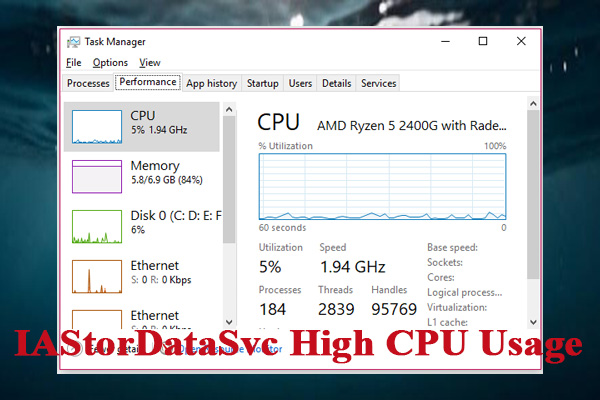Many users report that their computer is using much disk resource to read the DataStore.edb. What is DataStore.edb? Are you also troubled by the DataStore.edb huge issue? MiniTool will explore these questions together with you and provide solutions to fix the issue.
What Is DataStore.edb
To fix the high disk usage issue, it’s necessary to figure out what is DataStore.edb. DataStore.edb is a kind of Windows log file that’s located under the software distribution folder. This file is used to keep the history of all Windows updates.
That means the DataStore.edb log file will grow in disk size with every Windows Update check. So, you may find the system spends much time reading and writing to the DataStore.edb file, which slow down your PC considerably. When checking Windows update, you may find the svchost.exe process is using large disk resources to read Windows.edb file in Task Manager.
Is It Safe to Delete the DataStore.edb File
Is it safe to delete the DataStore.edb file? The answer is yes, however, it will start from scratch and check everything when checking Windows updates the next time. In other words, the DataStore.edb log file will be rebuilt again when checking Windows updates the next time.
So, there is no point in deleting the DataStore.edb file to fix the high disk usage issue. To fix the DataStore.edb huge issue basically, you need to empty the Windows software distribution folder. In addition, other effective methods are proved in the following part.
How to Fix DataStore.edb Huge Issue
Here we explore 3 effective methods to fix the DataStore.edb huge issue. Let’s keep reading now!
Fix 1. Disable Windows Update and Bits Service
As mentioned above, the DataStore.edb huge log file will grow in size with every Windows update check. So, you can try disabling the Windows Update and BITS services (help download and install Windows updates). Here’s how to do that:
Step 1. Press the Win + R keys to open the Run dialog box, and then type services.msc in the box and hit Enter.

Step 2. In the pop-up window, navigate to the Windows Update service, and then right-click it and select Properties.
Step 3. Now, change the Startup type to Disabled, and then click on OK and Apply to save this change.

Step 4. Then you can repeat the Steps 2-3 to disable the BITS service.
After disabling the services, reboot your computer and check if the disk resource has increased.
Fix 2. Use Esentutl.exe Utility to Defrag and Repair DataStore.edb
In addition, you can try using the esentutl.exe utility to defrag the DataStore.edb log file. Defragment the DataStore.edb file can help fix the large disk resource usage issue. Here’s how to do that:
Step 1. Type command in the search box, and then right-click the Command Prompt app and select Run as administrator.

Step 2. In the elevated command prompt, type the following command and hit Enter.
esentutl.exe /d C:windowsSoftwareDistributionDataStoreDataStore.edb
Step 3. Once this command is complete, restart your PC and see if the Windows.edb issue is fixed.
Fix 3. Recreate the SoftwareDistribution Folder
It is reported that the high disk usage issue has been fixed by recreating the Windows SoftwareDistribution folder. To do so, follow the steps below:
Step 1. Open the elevated command prompt through the above method.
Step 2. Type the following commands and hit Enter after one by one to disable the update service that makes use of SoftwareDistribution folder.
- net stop wuauserv
- net stop bits
Step 3. Then paste the following command in the elevate command prompt and hit Enter. This command will rename the SoftwareDistribution folder and force Windows to create a new SoftwareDistribution folder.
ren C:WindowsSoftwareDistribution SoftwareDistribution.old
Step 4. Restart your computer and press Win + E keys to open the File Explorer. Then to the C:/Windows folder and delete the SoftwareDistribution.old folder.


User Comments :